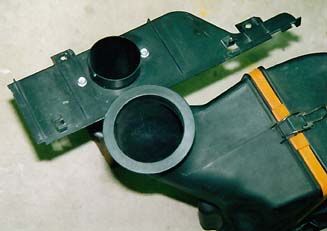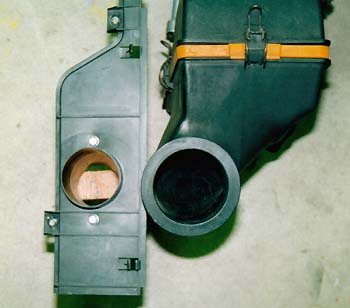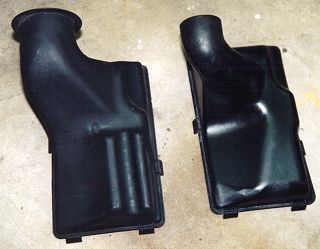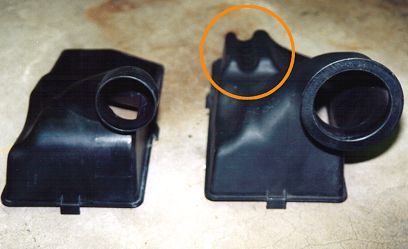
At some point around 1990 BMW Motorsport upgraded the lower half of the airbox (air filter housing) to a different style. The new style has a larger diameter intake and does not employ the short "bellows" type duct to feed air from the intake snorkel to the airbox. The newer airbox connects directly to the 1" section of the snorkel that protrudes through the radiator shroud into the engine compartment. | ||||

The photos show the comparison between the outlet of the EVO III intake snorkel and the intake to the EVO airbox. Note that the air flows from a small diameter to a much larger one. This is a curious situation. The EVO III plastic intake snorkel is generally assumed to be superior to the standard aluminum bent tube arrangement that came on all of the American E30 M3's. Even though the U.S. system was essentially "ram air" (both systems achieve "cold air induction"). The outlet diameter of the EVO III intake snorkel is the same as that of the original aluminum unit. Thus there appears to be no real reason that the EVO airbox has such a large inlet. The only explanation I can think of is that the sheer size of the intake system is not all there is to it. It is apparently also important to keep the flow laminar. The EVO III intake snorkel and the EVO airbox may be a better combination. Personally, I would like to dyno the car with the larger EVO airbox attached to a big cut out in the plastic radiator shroud to see if this improves performance. The later style BMW Motorsport Alpha-N carbon fiber race airbox's did not use the plastic shroud at all, but used that entire area as an intake! | ||||

A side-by-side comparison of the original lower airbox to the newer EVO style airbox clearly shows how much larger the intake is. Note the the diameter of the intake on the old airbox is roughly equal to the outlet diameter on the Evo III intake trumpet. So why is the EVO airbox so much bigger when it does not mate up to anything bigger? I am still not entirely sure about that. | ||||

Note that the new EVO airbox has a molded-in section where it can sit on the frame rail. This is highlighted by the orange circle. The original airbox appears to be designed to simply hang from the metal bracket, although Fred Larimer points out that the "early style" upper portion of the airbox has a special feature molded in to help support the airbox. Indeed Jim Butterworth's original airbox does display such a feature, but neither of us has had a chance to see how it is supposed to work. In any case, I much prefer the updated design for the mounting system. | ||||

Here is the part number straight from the EVO lower airbox, in case anyone is curious. | ||||
|
| ||||
|
Here are the part numbers for the various intake components as shown on the Mobile Traditions Parts CD:
| ||||
|
|